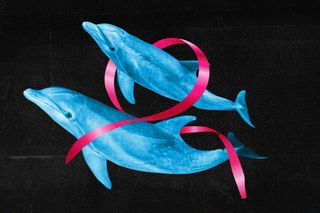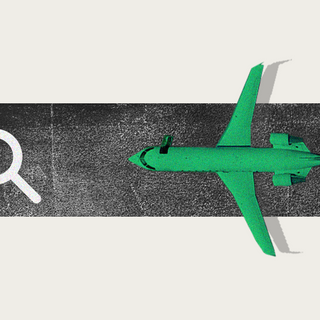
Male Dolphins Form Lifelong ‘Friends’ That Help Them Find Partners, Fight Competitors
This “strategic alliance” behavior was never previously confirmed among animals.

Cooperation is what defines our society: humans are known for their strategy, alliances, a deliberate sense of collaboration that helps us socially and culturally function. But this complex social system isn’t unique to us. Dolphins, who otherwise have quite the reputation in marine circles for their curiosity and endearing personalities, are also incredibly social. Male dolphins form lifelong (decade-long, in their cases) friendships with others. These cliques of sleek animals help each other mate with female dolphins, and even fend off enemies who may try to “steal” potential mates.
These are “alliances of alliances of alliances, really,” said Richard Connor, a behavioral ecologist at the University of Massachusetts Dartmouth.
Connor, along with other researchers, studied 202 Indo-Pacific bottlenose dolphins found in Western Australia’s Shark Bay between September and November, which is the dolphins’ peak mating season. Over a period of five years, the researchers observed the dolphins’ social habits, watching and listening to their whistles that function as unique communication patterns. Then, they focused exclusively on male dolphins and how their social circles operate: how alliances are formed, how long they last, what purpose they serve.
The researchers published their findings in PNASon Monday. What they observed was a social bond previously never confirmed in non-human animals: male dolphins relied on alliances with two or three other male dolphins — this could also increase to 14 — for breeding and protection reasons. These unspoken but understood alliances are long-term, stable, and critical to their life duration in the waters.
“It’s a significant investment that starts when they’re very young – and these relationships can last their entire lives,” said Stephanie King, professor in animal behavior at Bristol University and one of the authors of the study. King explained these males have clearly laid out loyalty.
“What happens as a male, you might be in a trio, herding a female. And if someone comes to take that female, the other males in your team and your second-order alliance come in and help you.” The researchers found the dolphins were connected to as many as 22 other dolphins (even 50 in some cases), a network that comes to help as a larger team if they sense any risk to their safety or breeding capacity.
Related on The Swaddle:
Whales Can Learn Songs From Each Other in a ‘Cultural Exchange,’ Finds Study
These are fascinating patterns of sociability within the male dolphin network. More so because up until now, the idea of cooperation and social alliances as a necessity for survival was thought to be unique to humans. Our motives, mechanisms, and even desires are rich and complex. But what the new research shows is that both “dolphins and humans have converged in the evolution of between-group alliances – an incredibly complex social system. And it’s astonishing because we are so different from dolphins,” Connor noted.
Social structures between dolphins bear an uncanny resemblance to human counterparts due to anatomy. There is something called the “social brain” hypothesis — a theory that assumes human brains evolved to process factual information about the world and manage large social systems. According to the hypothesis, even the present trait of having complex, multilevel social relationships is reserved only for mammals with large brain sizes.
And like humans, cooperation comes with competition at different levels too. Unrelated male dolphins were found to form three alliance levels — also called as “orders” — while competing over female dolphins for mating. There were alliances within the same friendship group (called first- and second-order) and between-group alliances (third-order), “based on cooperation between two or more second-order alliances against other groups,” the study noted. “Individual males may expand their strategic options by maintaining social familiarity with males outside of their three-level alliance network, possibly leading to the formation of new alliance relationships. Thus, each male navigates a multilevel alliance network of strongly differentiated social relationships.”
And arguably, this social bond among male dolphin networks is critical to their breeding function and the eventual survival of the species. The more well-knit, stronger the group, the more success they have in attracting females. Even male dolphins that are more socially connected with third-order allies had more success “consorting females.”
These dolphin societies are built around ideas of friendship, cooperation, and kinship — a network that is socially continuous. Tracing their patterns can also help us understand how humans too evolved socially and cognitively.
That humans and dolphins are the two animals with the largest brains in comparison to their body size is “not a coincidence,” Connor said.
Saumya Kalia is an Associate Editor at The Swaddle. Her journalism and writing explore issues of social justice, digital sub-cultures, media ecosystem, literature, and memory as they cut across socio-cultural periods. You can reach her at @Saumya_Kalia.
Related


Google Flights Changed How It Calculates Emissions, Making Air Travel Look Cleaner
